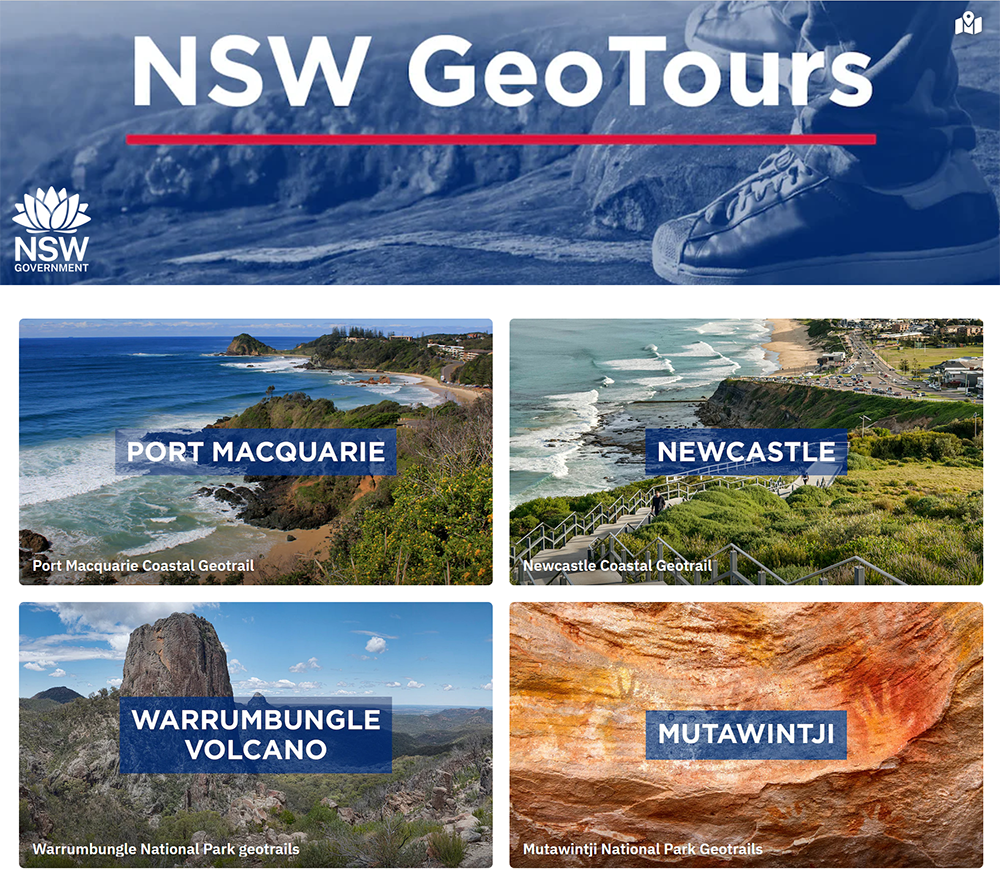SAGE Record 106, Boyd et al.
Boyd, R., G. Fleming, and B. Drabsch, 2022, Geotales and geotrails in New South Wales, Australia—Collaborative geotourism and education: SAGE Record 106, 3 p. + supplemental material, <http://sagetech.org/sage_record_106_boyd_et_al/>. Keynote oral presentation at SAGE AGES #3, 17 November 2022, Online.
KEYNOTE PRESENTATION: Geotales and Geotrails in New South Wales, Australia—Collaborative Geotourism and Education
Ron Boyd (University of Newcastle, Newcastle, New South Wales, Australia), Guy Fleming (Geological Survey of New South Wales, Maitland, New South Wales, Australia), and Bernadette Drabsch (University of Newcastle, Newcastle, New South Wales, Australia)

Geotrails provide an excellent opportunity to create new, place-based visitor experiences in regional locations which are self-guided, have low environmental or infrastructure impact, and are ideally suited to the social-distancing requirements of our post-COVID world. We have recently developed new geotrails in the state of New South Wales, Australia as highly collaborative partnerships between the NSW Government, the University of Newcastle and local stakeholders and site custodians, with the ultimate aim of creating a network of geotrails across NSW. Geotourism is defined for us as tourism which focuses on an area’s geology and landscape as the basis of fostering sustainable tourism development. A Geotrail delivers geotourism experiences through a journey linked by an area’s geology and landscape as the basis for providing visitor engagement, learning and enjoyment. They can also form part of the earth science curriculum content of schools and universities in the area, and are available online as virtual enjoyment and learning tools. The geotrails are delivered in the form of free, self-guided apps for mobile devices, brochures, web content and signage (if supported by site custodians). Additional high quality digital content such as spoken word audio, video, virtual reality imagery and podcasts provide even richer content to support the geotrail. Geotrails also provide an opportunity to incorporate complementary information, such as Aboriginal or European heritage, mining heritage and ecological features which may also have a relationship to the geology and landscape at a place. Integration of complementary information also adds greatly to visitor engagement and buy-in from local stakeholders or site custodians and can act as an enabler at relatively under-developed sites. Best practise geotrails are constructed around existing tourist routes which provide a logical and safe journey, incorporate local biodiversity and culture, meet the needs of visitors and local stakeholders, and allow for co-design and collaboration with local community and stakeholders during production. Examples of recent geotrails at Port Macquarie, Newcastle, and Warrumbungle National Park and geotrails in development at Mutawintji and along the Darling/Barka River (Figs. 1 and 2) illustrate best practise approach for successful design and development based on practical experience. In this presentation we will examine two Geotrail examples, concentrating first on a plate tectonic theme at Port Macquarie, and secondly a river landscape theme along the Darling/Barka River.
BIOGRAPHY: Dr. Ron Boyd is an Honorary Associate Professor of Earth Sciences at the University of Newcastle. He holds Ph.D. and B.Sc. (Hons.) degrees in Earth Sciences from the University of Sydney. He has taught and researched earth science in Australia, USA, Canada, China, and Europe and has published over 220 research papers on this subject. He has worked in industry as a Principal Geologist with ConocoPhillips Company and PanCanadian Petroleum. Ron Boyd has been a chief scientist on the Australian National Facility RV Franklin and RV Southern Surveyor, a geologist on the Ocean Drilling Program, an AAPG Distinguished Lecturer, and a Humbolt Fellow. He currently is mainly involved in community earth science projects including geotourism/geoeducation and coastal management in New South Wales.

Figure 1. Professor Ron Boyd at Shelley Beach, Port Macquarie, Australia. Photo courtesy of the Australian Broadcast Corporation Mid North Coast: Emma Siossian. Please visit https://www.abc.net.au/news/2018-05-04/port-macquarie-geotrail-offers-glimpse-460-million-years-ago/9722164 for more details.

Figure 2. Geotours/geotrails in New South Wales, Australia.
Boyd, R., G. Fleming, and B. Drabsch, 2022, Geotales and geotrails in New South Wales, Australia—Collaborative geotourism and education: SAGE Record 106, supplemental video, <http://hpr.oys.temporary.site/website_846cd7f6/sage_record_106_boyd_et_al/>. Keynote oral presentation at SAGE AGES #3, 17 November 2022, Online.

